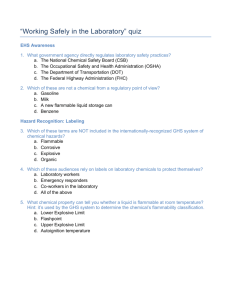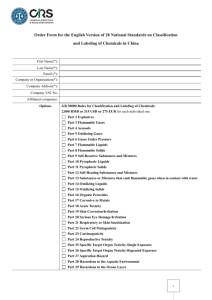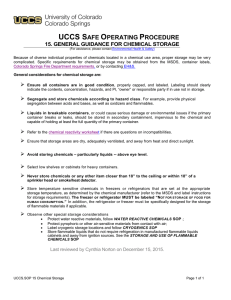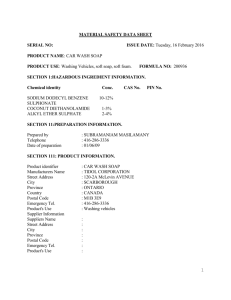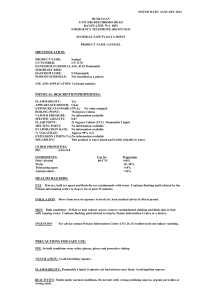Safe Operating Procedure (1/13) FLAMMABLE SOLIDS HAZARDS & RISK MINIMIZATION
advertisement
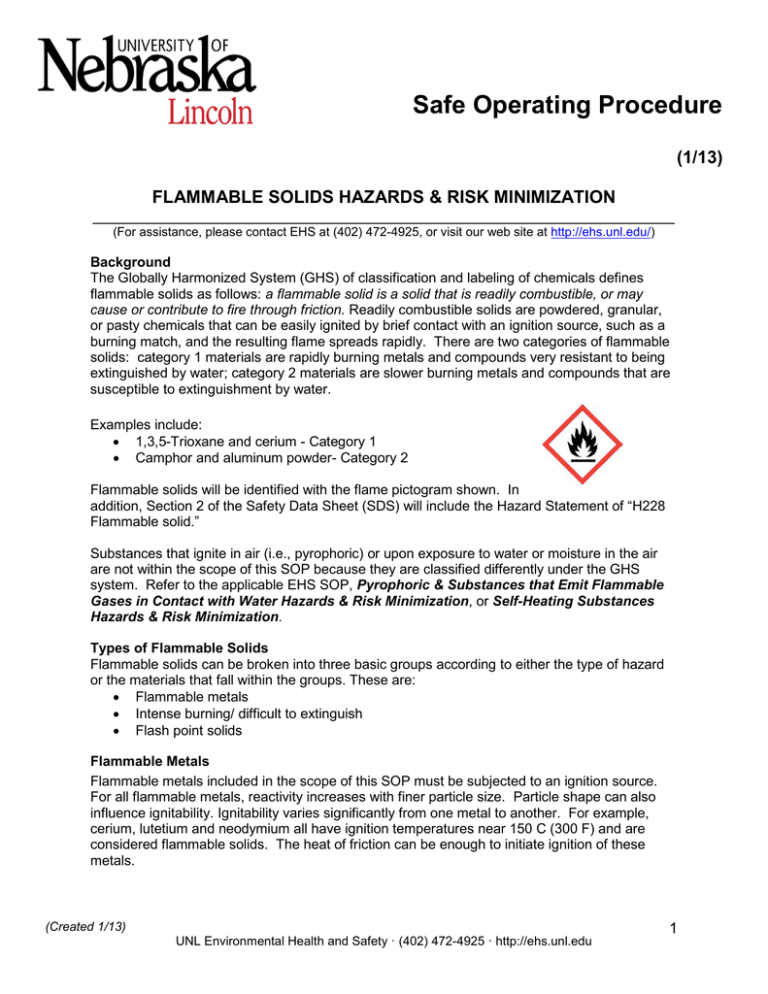
Safe Operating Procedure (1/13) FLAMMABLE SOLIDS HAZARDS & RISK MINIMIZATION _____________________________________________________________________ (For assistance, please contact EHS at (402) 472-4925, or visit our web site at http://ehs.unl.edu/) Background The Globally Harmonized System (GHS) of classification and labeling of chemicals defines flammable solids as follows: a flammable solid is a solid that is readily combustible, or may cause or contribute to fire through friction. Readily combustible solids are powdered, granular, or pasty chemicals that can be easily ignited by brief contact with an ignition source, such as a burning match, and the resulting flame spreads rapidly. There are two categories of flammable solids: category 1 materials are rapidly burning metals and compounds very resistant to being extinguished by water; category 2 materials are slower burning metals and compounds that are susceptible to extinguishment by water. Examples include: • 1,3,5-Trioxane and cerium - Category 1 • Camphor and aluminum powder- Category 2 Flammable solids will be identified with the flame pictogram shown. In addition, Section 2 of the Safety Data Sheet (SDS) will include the Hazard Statement of “H228 Flammable solid.” Substances that ignite in air (i.e., pyrophoric) or upon exposure to water or moisture in the air are not within the scope of this SOP because they are classified differently under the GHS system. Refer to the applicable EHS SOP, Pyrophoric & Substances that Emit Flammable Gases in Contact with Water Hazards & Risk Minimization, or Self-Heating Substances Hazards & Risk Minimization. Types of Flammable Solids Flammable solids can be broken into three basic groups according to either the type of hazard or the materials that fall within the groups. These are: • Flammable metals • Intense burning/ difficult to extinguish • Flash point solids Flammable Metals Flammable metals included in the scope of this SOP must be subjected to an ignition source. For all flammable metals, reactivity increases with finer particle size. Particle shape can also influence ignitability. Ignitability varies significantly from one metal to another. For example, cerium, lutetium and neodymium all have ignition temperatures near 150 C (300 F) and are considered flammable solids. The heat of friction can be enough to initiate ignition of these metals. (Created 1/13) UNL Environmental Health and Safety · (402) 472-4925 · http://ehs.unl.edu 1 In contrast, the ignition temperature of iron is somewhere between 1450 C to 1500 C (2640 F to 2730 F), and it is not considered a flammable solid. Iron ground (i.e., filed) by hand using a stone produces no sparks. Once ignited, flammable metals/elements burn very intensely and generate a great amount of heat. Temperatures can reach 2,500 C (4,530 F). Examples of flammable metals include but are not limited to the following: cerium, lutetium, silicon (powder), neodymium (in some forms), and aluminum (granules). Intense Burning/Difficult to Extinguish Examples of solids that burn intensely and are difficult to extinguish include the following: • Oxygen containing chemicals (e.g.,1,3,5-trioxane, metaldehyde) • Nitrogen containing chemicals (e.g., hexamethylenetetramine) • Nitro-group chemicals (e.g., nitrocellulose) • Mixtures (e.g., flares, thermite) The presence of nitrogen and oxygen in these chemicals is why they burn so fiercely and are so difficult to extinguish. If under certain confinement conditions, some of the chemicals will explode. Flash Point Solids The flash point solids are a small group of materials. Examples include paraformaldehyde, naphthalene (moth balls), and camphor. Flash point solids sublime (i.e., change directly into a vapor without passing through the liquid state). As a result, these materials have flash points, and ignite in a manner similar to combustible liquids. Once ignited, the materials will melt and flow, like a flammable liquid. Additional Hazards The primary hazard of flammable solids is that they ignite readily, burn fiercely, and are difficult to impossible to extinguish. Some are toxic or produce toxic combustion products. Mitigating the Risks of Flammable Solids First and foremost, verify that a comprehensive and project-specific hazard analysis/risk assessment with additional oversight is not in order, as described in the companion EHS SOP, Chemical Hazard Assessment and Risk Minimization. General risk mitigation measures area as follows: • Conduct a thorough literature search, including review of Safety Data Sheets, to establish a thorough understanding of the properties of the flammable solids to be handled with particular consideration given to the procedures and tasks to be conducted. • Follow general safe chemical handling practices as described in the EHS SOP, General Guidance for Chemical Ordering, Receipt, Distribution, Use, and Storage. • Purchase the most stable chemical that will do the job. • For metals, purchase the largest mesh size that will do the job. Do not order powders if granuals will work. • Keep amounts on-hand to a minimum. Store in a cool, dry place and away from other flammable and combustible materials. • Conduct work on the smallest scale possible. • Observe all specific safety procedures established for the laboratory/procedure. (Created 1/13) UNL Environmental Health and Safety · (402) 472-4925 · http://ehs.unl.edu 2 • • • • • • • • • Do not attempt to crush or grind a flammable solid. Keep the threads of containers clean for the same reason. Identify and eliminate sources of static discharge as some flammable solids can be inititated in this manner. Sources of static include clothing, the use of plastic, and the transfer of materials between containers. Low humidity environments (i.e., dry rooms) also increase the potential for static. Conduct work in a fume hood. Only those chemicals involved in the operation should be in the vicinity of the work being done. Bottles/containers from which they were dispensed and other chemicals need to be put away. Most flammable solids burn so intensely, they can easily involve other nearby chemicals/containers. Avoid the hazards of work at elevated temperatures; implement appropriate risk mitigation measures. Keep the work area, tools and equipment scrupulously clean. Do not allow flammable solids to build up. Use non-static wipes or wet methods, as appropriate, to clean use areas. Give very careful consideration to the containers, apparatus to be used and surfaces on which the work is done. Most materials (e.g., bottles, flasks, countertops) expand when they are heated. If the flammable solid were to ignite, the rapid, localized and intense heating can make materials that they are in contact with expand without time to adjust for the strain and crack, shatter, or spall violently. This is called thermal shock. Know how to use a fire extinguisher and have a Class D fire extinguisher readily available. See EHS SOP, Fire Safety – General Prevention and Extinguishers and EHS web-based training, Fire Extinguisher Training for more information. Wear appropriate lab/work attire and PPE. Appropriate attire consists of closed-toed shoes and garments made of non-synthetic materials. Minimum PPE consists of flame resistant lab coats (or similar outer garment) and eye protection. Additional PPE may be necessary. See EHS SOP, Personal Protective Equipment for Chemical Exposures. (Created 1/13) UNL Environmental Health and Safety · (402) 472-4925 · http://ehs.unl.edu 3

